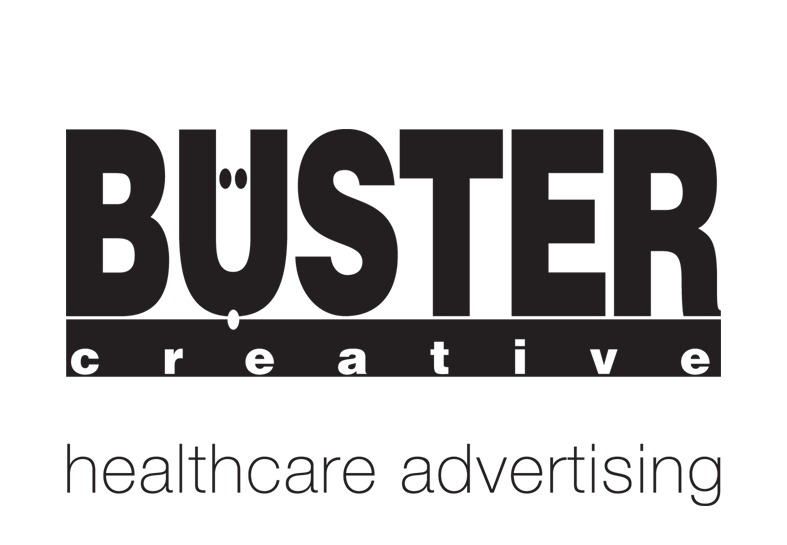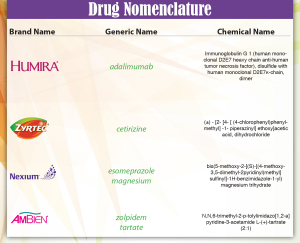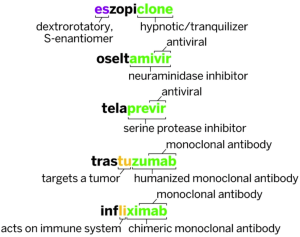How do generic versions of drugs get their names?
OK, so we know how branded pharmaceuticals are named. You hire a stuffy agency to embark on a exhaustive research program and develop synthetic linguistic constructs from morphemes so that it can be easily trademarked and can be utilized in all foreign languages. Or, the CEO’s spouse suggests something.
Either way the name is created and millions are spent marketing it.
But how about the generic name? Where do those come from? Many times the generic name is as crazy and obtuse as the branded name. Actually there are three names for each branded drug: The brand name, the generic name and chemical name. The chemical names are almost never used because they describe the chemical structure of the drug molecule and can get longish. For example, Tylenol (acetaminophen) is also know as N-(4-hydroxyphenyl)acetamide.
Generic drug naming is more fun, so we’ll discuss that today. From an article in Chemical and Engineering News:
Generic names usually describe a drug’s physiological function rather than its chemical structure. Today’s regimented generic-naming process got its start in the 1960s, a time when drugs had grown complex in structure and IUPAC names had grown to unwieldy lengths. In 1961, the American Medical Association, the U.S. Pharmacopeial Convention, and the American Pharmacists Association created the U.S. Adopted Names (USAN) Council to select concise generic names. The Food & Drug Administration joined the effort in 1967.
Today, the USAN Council names the active ingredients in drugs, biologics, vaccines, and even contact lenses and sunscreens. The council recommends names to the World Health Organization’s (WHO) International Nonproprietary Names (INN) program, which ultimately chooses a single name for each new drug that’s acceptable worldwide. For drugmakers, obtaining a generic name is a required part of bringing new products to market. Choosing a brand, or trade, name is an entirely separate process.
USAN Council members believe it’s important to develop drug names that are free for anyone to use, says Ruta Freimanis, who served as associate executive secretary and then as executive secretary of the USAN Council between 1978 and 2000. Brand names might be handy at first, “but eventually drugs do go off patent,??? she says. A generic name “can go in the literature, on package labels, or even in educational materials??? without copyright issues related to brand names, she explains.
The naming process itself “is an evolving type of science,??? says Stephanie C. Shubat, the current director and secretary to the USAN Council. Generic names have evolved from being truncated versions of chemical terminology to being largely independent of it, she explains.
A list of naming rules, some of them quirky, has evolved as well. The letters h, j, k, and w are off-limits because they lead to pronunciation problems in other languages. Drugmakers can suggest names to the USAN Council, but any name with an implication that a drug is better, newer, or more effective than the competition heads straight for the reject pile, Shubat says. When a prospective name reaches the WHO stage, international connotations come into play. A name that sounds perfectly fine in English might have bad or even obscene connotations elsewhere. No one wants to sell the Chevy Nova of the drug world.
The crux of the generic-naming system is a collection of short name fragments called stems. Each stem has a meaning connected to a particular drug class or mode of action. The official list of USAN and INN stems and substems has grown and changed over time as companies come up with new classes of drugs, Shubat explains.
Understanding drug names through stems is a lot like learning English vocabulary by studying Greek and Latin roots. Learn what the stems mean, and you’re most of the way to figuring out what a drug does. Take top-selling drug Nexium, which has a generic name of esomeprazole. The stem in that name is -prazole, which means the drug is a benzimidazole antiulcer agent. The drug’s es- prefix describes the nature of the drug’s chirality—esomeprazole is dextrorotatory and contains a chiral center in the S configuration.
This is just the tiny tip of the complexity in generic drug naming. Here is more background if you’re interested:




